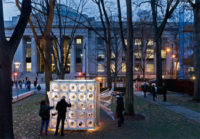Obituary: Jordan L. Gruzen, FAIA, 1934-2015

On Tuesday, January 27, 2015, Jordan L. Gruzen, FAIA, died in New York City after a brief bout with bladder cancer. He was 80 years old. Gruzen, along with his long-time colleague and partner Peter Samton, designed schools, universities, housing complexes, and civic and religious buildings that staunchly upheld the principles of modernist architecture with a well-tailored, straightforward use of materials. Their firm, named IBI Group-Gruzen Samton following a merger in 2009, has imparted its stamp on New York and the surrounding metropolitan area over more than four decades. Projects abroad have included the U.S. Embassy in Moscow (in joint venture with Skidmore, Owings & Merrill), housing in Tehran, Dubai, and an office building in Nairobi.
 |
| Photo courtesy IBI Group Gruzen Samton Jordan Gruzen, far right, walking with New York City Mayor John Lindsay, center, 1973.
|
The son of New York architect, B. Sumner (Barney) Gruzen, Jordan received his B.Arch. from Massachusetts Institute of Technology (MIT) in 1957, went to Italy on a Fulbright, and got his M.Arch. from the University of Pennsylvania in 1961. Soon afterward he joined up with his father, who had co-founded Kelly and Gruzen in 1936, where the younger Gruzen worked on the much published, poured-in-place concrete Chatham Towers, built to provide middle-income housing to New York City (1965).
While at MIT, the younger Gruzen had met Peter Samton, who joined him at Kelly and Gruzen in late 1962. The two became partners in 1967, and the firm name was changed to Gruzen and Partners, and later to the Gruzen Partnership, and then in 1986 to Gruzen Samton. “Jordan was an extremely positive person,” recalls Samton, looking back over the 50 years he had worked with Gruzen. “While Barney was tough, Jordan had such a gregarious, easy personality. ”In addition Samton notes his partner’s commitment to a rehabilitative prison design in the late 1960s and 1970s. “He always had a sense of wanting to do the right thing.”
Similarly, Gruzen expressed a strong interest in preservation, evident as early as 1962, when he and a number of colleagues (including Samton) protested the demolition of Penn Station. The McKim, Mead & White structure (1910) was torn down in the next few years, one of New York City’s most ill-fated decisions. But the interest in preservation and its related efforts stayed with him through his life, as shown by the colorful but sympathetic renovation of the brick-and-limestone, 1920s structure for El Museo del Barrio on Upper Fifth Avenue (2009).
Jordan Gruzen is survived by his wife, Lee, their daughters, Rachel and Georgia, and his son Alex.


.jpg?height=200&t=1720083531&width=200)


